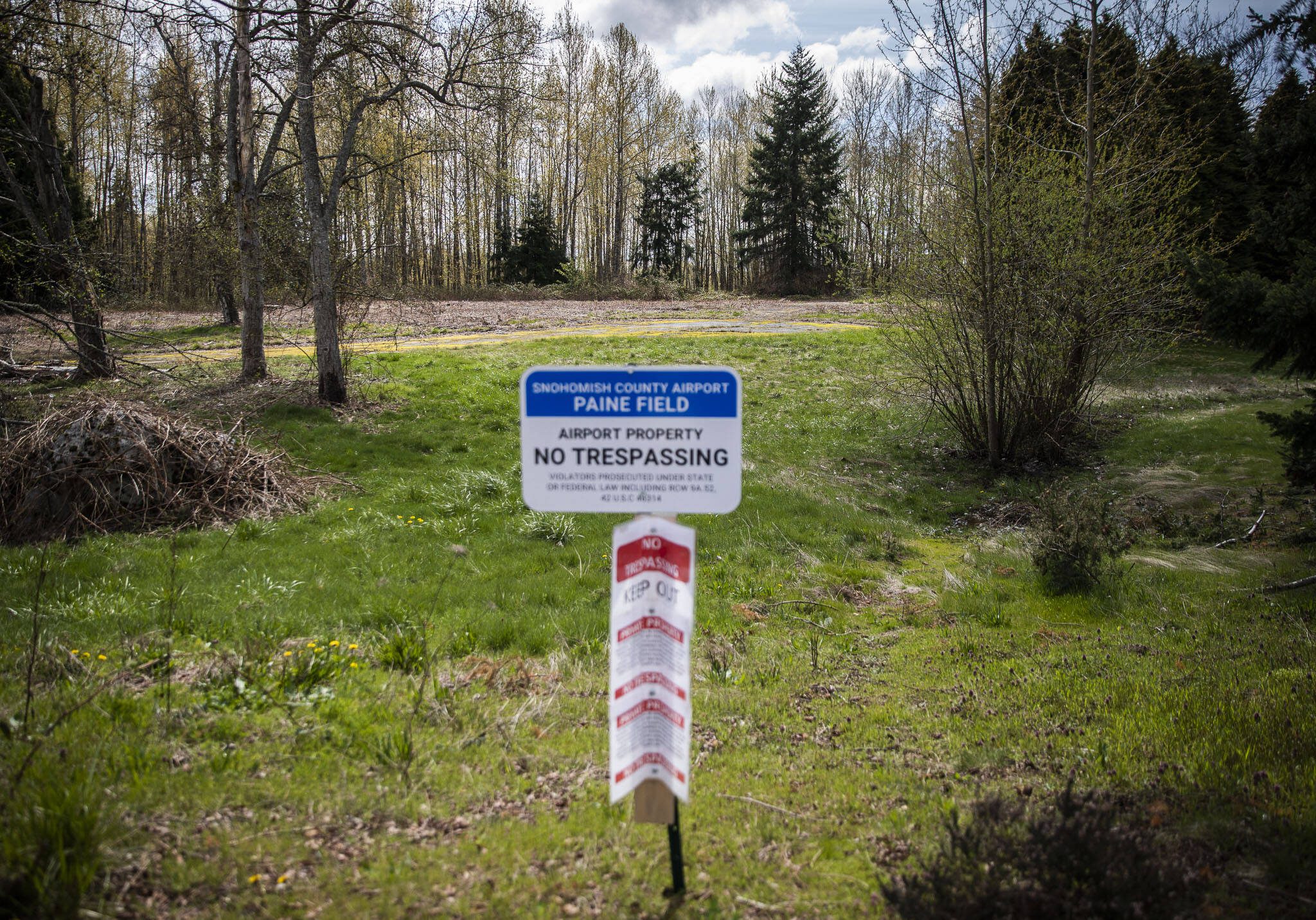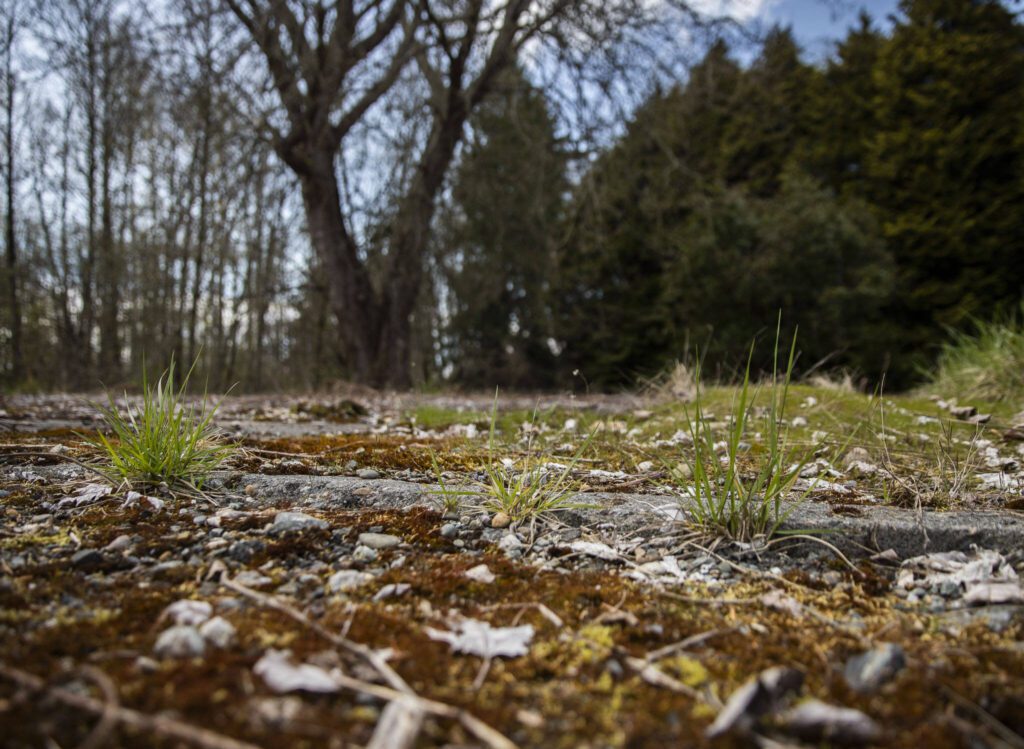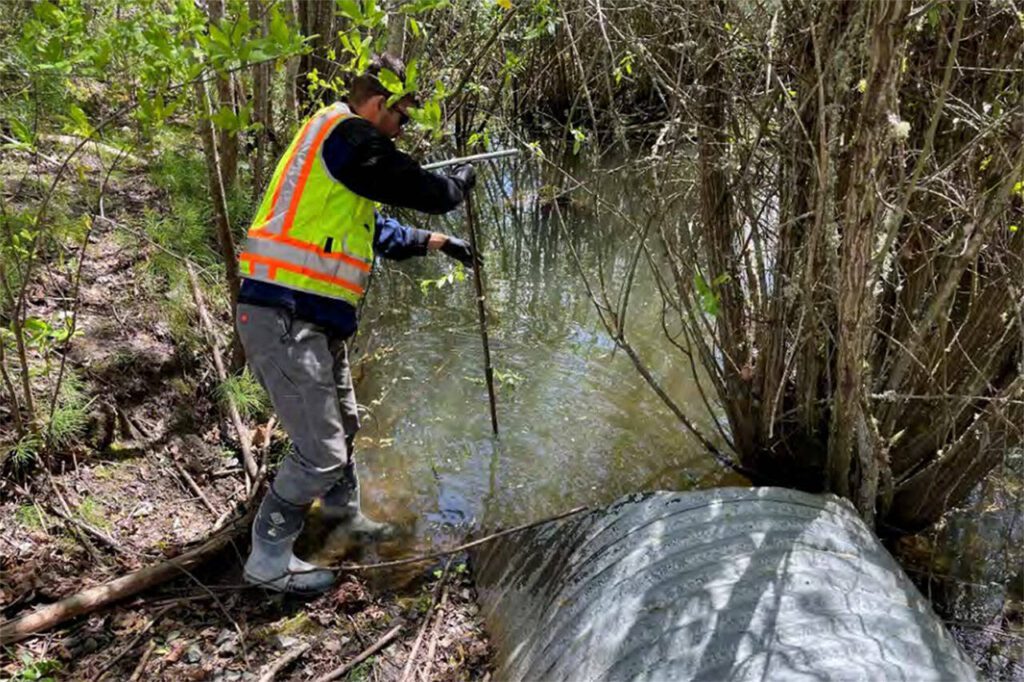EVERETT — Late on the afternoon of May 20, 2014, construction workers at Boeing’s massive Everett Modification Center at Paine Field accidentally cut a wire.
The mistake activated the building’s long-unused fire suppression system, spilling hundreds of thousands of gallons of water and firefighting foam into the building, overwhelming its sewer system and eventually flowing into wetlands to the southwest.
The foam, containing dangerous per- and polyfluoroalkyl substances, or so-called forever chemicals, spread into the soil at levels an analysis last year found was dozens of times above state recommendations.
As a result, the state Department of Ecology last month added the area to its small but growing list of PFAS-contaminated cleanup sites around the state.
“Unfortunately, once they’re there, wherever they’ve decided to sorb to, soil, groundwater, other things down there, they’re kinda stuck there without some intervention,” said Kim Wooten, of Ecology’s toxics cleanup program.
Airport officials last month said there is “absolutely no risk to drinking water.”
Some health concerns remain, however, when such chemicals get into soil and groundwater, according to researchers.
Paine Field is the third Snohomish County site where state investigators have reported PFAS suspicions. A 2021 report found one spot at Naval Station Everett and six at the Jim Creek radio station in Arlington. The Navy has since taken samples from the soil and groundwater from those areas and results are expected to be released later this year, said Kendra Clubb, the PFAS lead project manager for Naval Facilities Engineering Systems Command Northwest.
The waterfront naval base has a history of firefighting foam use, but testing in late 2021 found no sign of the chemicals in drinking water.
‘It’s all pretty new’
Sites across the state where high levels of PFAS have been confirmed include an airport in Kennewick, an Army training center in Yakima and a cluster of locations in Issaquah, including a fire station and an elementary school. The state also suspects the emerging chemicals remain at other Western Washington naval stations, including on Whidbey Island.
Termed “forever chemicals,” PFAS consumption can cause health defects, from cancer to lower birth weights to increased cholesterol levels to decreased vaccine response in children, according to the Centers for Disease Control and Prevention.
And they’re pervasive. The chemicals are in nonstick pans and clothing. In some shampoo and dental floss. And in firefighting foam, which has emerged as a major source of the dangerous and persistent chemicals.
That’s the issue at the Paine Field site, where aqueous film-forming foam has long been used for fire suppression and training.
Tucked in this year’s budget, the County Council requested the Snohomish County Airport prepare a plan for transitioning away from the chemicals. The council requested the plan be presented by the end of August.
Used for decades, awareness of the chemicals has only grown in recent years.
Alissa Cordner, an associate sociology professor at Whitman College, started looking into PFAS about 10 years ago.
“We wanted to understand why there was a mismatch between what seemed to us to be a pretty well-developed literature on toxicity and exposure concerns related to this class of chemicals and, yet, very little regulatory action and very little public awareness,” said Cordner, who is also co-director of the PFAS Project Lab. “And since then, PFAS have become such a huge priority.”
Authorities are still figuring out recommendations for when cleanup should be done on PFAS-contaminated sites, a testament to their recent emergence.
“It’s all pretty new,” Ecology spokesperson Cheryl Ann Bishop said. “All of the states and the feds, we’re all still trying to understand this contamination and what it means.”
At Paine Field, this could be just the tip of the iceberg.
‘Did it go further?’
Boeing’s Everett Modification Center has long had a fire suppression system, dating back to past owners at the property off 112th Street SW in south Everett.
That system used aqueous film-forming foam. That film is created by PFAS.
“They work really well at what they do in those foams,” Wooten said. “There’s a reason they were in those foams. They’re very, very good at fire suppression in a hurry.”
And it’s responsible for most drinking water contaminated with the forever chemicals across the country, where foam has contaminated nearby wells. As testing becomes more common, PFAS contamination will likely be found to varying degrees across Snohomish County.
The recent samples taken at Paine Field, collected from a few spots in May and June last year by Seattle firm Shannon & Wilson, found PFOS, a type of PFAS, in the soil at over 160 times the current state recommendation level for cleanup. Other chemicals in the class were also above the guidance.
However, whether the samples, taken from spots covered by water, could truly be considered soil is questionable. Wooten said they could be better termed sediment, but the state hasn’t yet set cleanup levels for PFAS in sediment.
The results also showed high concentrations for other PFAS chemicals that don’t yet have state thresholds for cleanup.
Cordner, of the PFAS lab, also noted some chemicals that weren’t detected could still be in the soil, but the sampling methods just can’t find them at lower levels.
Wooten determined the preliminary results warrant more investigation.
The next step will be more sampling to figure out where else the chemicals may have reached.
“Did it go further? If it did go further, how much further?” said airport spokesperson Kristin Banfield. “What is it going to take to clean it up? How long is it going to take to clean it up? All of those steps would come future down the line.”
In a statement this week, a Boeing spokesperson said the company was aware of the sampling at the site.
“Boeing will continue to monitor the progress of the inquiry, which will include evaluation of potential sources of contamination,” the statement reads. “Boeing is committed to cleaning up and restoring sites that have been affected by its past practices.”
The county plans to continue investigating for PFAS at other sites at Paine Field.
Banfield said the airport wants to “do our due diligence and make sure we’re doing our part in making sure our community is well protected.”
Meanwhile, those consuming Everett’s drinking water need not worry, city officials say.
In 2014, tests found no PFAS in the city’s drinking water, sourced from the Spada reservoir about 30 miles east of the city. Everett is continuing to monitor for PFAS once per quarter this year.
‘Cause for concern’
Four years after the spill at the modification center, state lawmakers in Olympia banned the use of firefighting foam containing PFAS in training.
The Legislature has also banned the product from being manufactured or sold in Washington. It can still be used for emergencies.
The state is now developing a program to collect and dispose of aqueous film-forming foam.
At Tulalip Bay Fire, the department has 10 jugs, each filled with 5 gallons of the firefighting foam, Fire Chief Ryan Shaughnessy said. It’s been sitting near the agency’s main fire station alongside paint and gasoline since the law went into effect. He has tried to figure out a way to get rid of it, to no avail.
“Trying to find a place to dispose of it has been incredibly challenging,” Shaughnessy said.
In Tulalip, firefighters rarely used the foam on calls, but more often for training. The chief figures any firefighter before 2018 was using it.
“There’s cause for concern, for sure,” Shaughnessy said.
South County Fire has 16 of those 5-gallon jugs that have long remained sealed in a secured storage room.
At airports like Paine Field, federal authorities require annual testing of the foam. But in 2021, Ecology launched a program to allow airports to conduct the tests in boxes to minimize ground contamination. Banfield said Paine Field was one of the first Washington airports to deploy the box.
PFAS aren’t the only worrisome chemicals found at the Boeing site.
In 2011, before the jet giant owned the property, the state confirmed the presence of trichloroethylene in the soil beneath the hangar. Commonly used in industrial solvents, trichloroethylene, or TCE, has been linked to cancer. The site is still awaiting cleanup, according to Ecology.
At another active Boeing cleanup site in Everett, the company last year got a one-year extension for working on the cleanup because of the potential presence of PFAS in the former south fire pit off Airport Road near Boeing Lake.
Jake Goldstein-Street: 425-339-3439; jake.goldstein-street@heraldnet.com; Twitter: @GoldsteinStreet.
Talk to us
> Give us your news tips.
> Send us a letter to the editor.
> More Herald contact information.



























